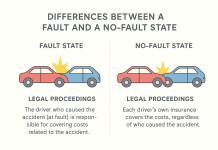Pain doesn’t show up on an X-ray. You can’t scan for sleepless nights, the ache of anxiety, or the quiet grief of missing out on life. Yet when someone is injured, whether in a car crash, a fall, or another traumatic event, these invisible wounds are often the most lasting.
Putting a dollar value on something so deeply personal might seem impossible. But in personal injury law, it’s necessary. Here in this blog, we will discuss how to calculate compensation for pain and suffering using different calculation methods.
What Exactly Is Pain and Suffering?
After an accident, injuries may lead to physical pain and emotional anguish; we refer to this as pain and suffering. Physical agony and emotional trauma fall under the category of pain and suffering when dealing with personal injuries. The range includes lasting nerve damage and ongoing migraines together with negative mental states, including phobias and depressive symptoms, as well as decreased quality of life.
Pain lacks a medical billing receipt that would validate its cost. Despite its intangible nature, courts, and insurance entities require a value assignment. The calculation methods appear at this stage to perform their function.
A formal process exists for attorneys and adjusters to decide appropriate compensation amounts for matters that have no objective value. The right approach safeguards more than monetary compensation because it provides both recognition and legal fairness.
How Do Professionals Calculate Compensation?
1. The Multiplier Method
The multiplier method stands among the main techniques used to estimate pain and suffering amounts. Economic damages made up of medical expenses and salary losses undergo multiplication using factors ranging from 1.5 to 5.
The more severe and long-lasting the injury, the higher the multiplier. Someone with economic damages of $20,000 could obtain $60,000 in pain and suffering through this method because their significant emotional trauma and persistent pain led to a multiplier value of 3.
2. The Per Diem Method
The per diem (Latin for “per day”) calculation method establishes daily monetary values to represent the discomfort suffered by the individual. The assigned rate gets multiplied by the estimated length of anticipated suffering of the injured party. A person who suffers for 180 days can receive $27,000 in pain and suffering compensation based on a $150 per day rate.
The main difficulty in this method involves establishing proper daily compensation rates. When determining this figure, courts consider both what the person earns and current economic conditions. Understanding how professionals calculate compensation for pain and suffering also involves considering case law, psychological evaluations, and even expert testimony.
What Affects the Final Compensation?
Several factors affect the amount awarded for pain and suffering, including:
- Recovery time: Short-term injuries often receive less compensation than permanent ones.
- Impact on emotional and mental health: The injury can cause anxiety, PTSD, and depression, which will have a big effect on the compensation, depending on if this is backed up with medical evaluations.
- Disruption of work and daily activities: If an injury means a person is unable to work, look after the family, or engage in normal activities, then it makes a strong case.
- Medical documentation: Strong records from doctors and therapists adds credibility. As noted by the U.S. National Library of Medicine, detailed clinical records not only support diagnosis and treatment but also serve as critical legal documentation in personal injury cases.
Conclusion
The ultimate value determination of pain goes beyond mathematical calculations because it needs to be recognized rather than measured. These methods basically guarantee legal recognition of experiences even when they remain invisible to the judicial system. To understand the judicial process for finding this balance, users can access resources from the National Center for State Courts regarding civil justice and damage assessment.






![Kodi Blamo Repo: Is it Dead? [New Source and Best Alternatives]](https://www.meritline.com/wp-content/uploads/2019/03/feature-4-100x70.jpg)

